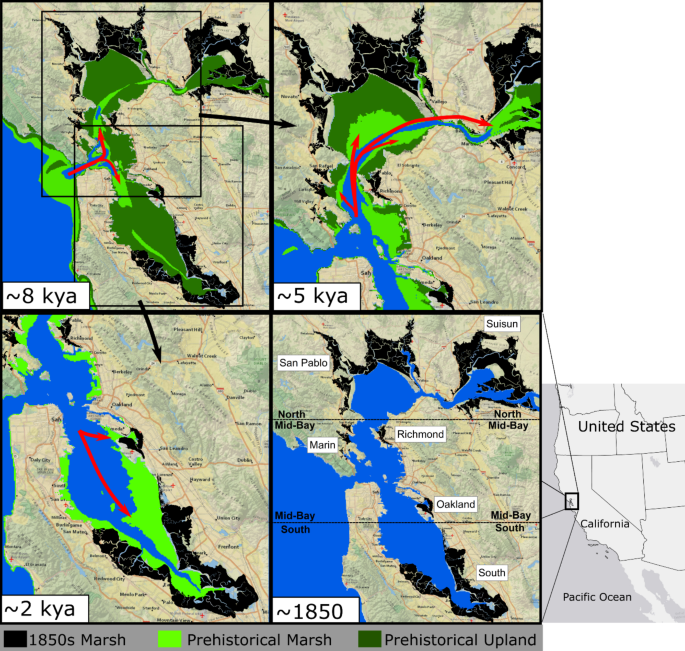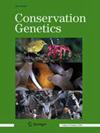Evolutionary history of the salt marsh harvest mouse mitogenome is concordant with ancient patterns of sea level rise
IF 1.7
3区 环境科学与生态学
Q2 BIODIVERSITY CONSERVATION
引用次数: 0
Abstract
Abstract Coastal wetland ecosystems support unique biodiversity and are imminently threatened by climate change-driven sea level rise. However, the impact of climate change on their demographic and evolutionary histories is poorly understood. To improve our understanding, we examined how past climatic events have shaped the evolutionary history of the salt marsh harvest mouse ( Reithrodontomys raviventris ), an endangered species and a salt marsh habitat specialist, completely restricted to coastal wetlands in the San Francisco Estuary (SFE). We used whole mitochondrial genome sequences of 102 salt marsh harvest mice to characterize phylogeography and demographic history. Then, we predicted the ancient distribution of salt marsh habitat and examined correspondence between divergence, demographic history, and changes in ancient marsh habitat caused by sea level rise. A Bayesian Skyline Plot revealed demographic expansions during periods of sea level rise, particularly during the formation of the modern SFE (~ 10 kya), and rapid decline consistent with recent anthropogenic landscape change. Bayesian estimates of divergence time were consistent with subspecies divergence ~ 10 kya, and subpopulation divergence ~ 5 kya, consistent with multiple episodes of vicariance caused by Holocene sea level rise. Spatial Analysis of Molecular Variance and Φ ST revealed a mismatch between the morphological and molecular subspecies assignment of two populations. Our study implicates sea level rise as a force of demographic change and evolutionary divergence in coastal marsh ecosystems. Our study also aids conservation of an endangered species by clarifying genetic subspecies boundaries and highlighting the unique nature of isolated populations that are increasingly threatened by modern sea level rise.

盐沼收获鼠有丝分裂基因组的进化史与古代海平面上升模式一致
沿海湿地生态系统支持独特的生物多样性,并受到气候变化驱动的海平面上升的紧迫威胁。然而,气候变化对其人口和进化史的影响知之甚少。为了提高我们的理解,我们研究了过去的气候事件是如何塑造盐沼收获鼠(Reithrodontomys raviventris)的进化史的。盐沼收获鼠是一种濒危物种,也是盐沼栖息地专家,完全局限于旧金山河口(SFE)的沿海湿地。我们使用102只盐沼收获鼠的全线粒体基因组序列来表征系统地理学和人口统计学历史。在此基础上,对古盐沼生境的分布进行了预测,并考察了海平面上升引起的古盐沼生境变化与分化、人口历史的对应关系。贝叶斯天际线图显示,在海平面上升期间,特别是在现代SFE形成期间(~ 10 kya),人口增长迅速,与最近的人为景观变化一致。贝叶斯估计的分化时间与亚种分化~ 10 kya和亚种群分化~ 5 kya相一致,与全新世海平面上升引起的多次变异相一致。分子变异空间分析和Φ ST分析表明,两个居群的亚种归属存在形态和分子上的不匹配。我们的研究暗示海平面上升是沿海沼泽生态系统人口变化和进化分化的力量。我们的研究还通过澄清遗传亚种界限和突出受现代海平面上升日益威胁的孤立种群的独特性,帮助保护濒危物种。
本文章由计算机程序翻译,如有差异,请以英文原文为准。
求助全文
约1分钟内获得全文
求助全文
来源期刊

Conservation Genetics
环境科学-生物多样性保护
CiteScore
3.80
自引率
4.50%
发文量
58
审稿时长
1 months
期刊介绍:
Conservation Genetics promotes the conservation of biodiversity by providing a forum for data and ideas, aiding the further development of this area of study. Contributions include work from the disciplines of population genetics, molecular ecology, molecular biology, evolutionary biology, systematics, forensics, and others. The focus is on genetic and evolutionary applications to problems of conservation, reflecting the diversity of concerns relevant to conservation biology. Studies are based on up-to-date technologies, including genomic methodologies. The journal publishes original research papers, short communications, review papers and perspectives.
 求助内容:
求助内容: 应助结果提醒方式:
应助结果提醒方式:


